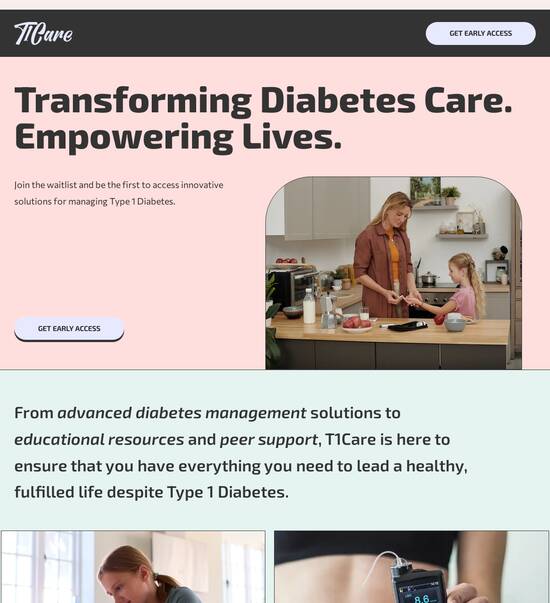
Website Template for Key Account Managers
Explore Similar TemplatesAbout template
Create customized landing pages quickly with 500+ conversion-focused layouts and optimization features to increase conversions, brand trust, and customer loyalty. No coding required.
Recommended templates

Easy to build without coding
With the intuitive drag-and-drop builder, anyone on your team can create high-converting pages without any knowledge of code or design. Make enhancements to your landing page with custom widgets using Javascript, HTML/CSS, or third-party scripts.

Multiple layouts for any industry and goal
Select from 500+ landing page layouts built to boost conversions across industry-specific scenarios. Customize them by adjusting fonts, adding images, and generating on-brand content with the AI assistant. Quickly scale with Instablocks® and Global Blocks that you can save, reuse, and update globally.

Loads fast and looks polished on any device
Every template is responsive, which means they present professionally on any device and load blazingly fast with our Thor Render Engine. You can also power them up with Google AMP technology to deliver an unparalleled mobile experience and drive higher conversions.

Robust analytics & experimentation
Get real-time updates and reporting across all your devices, showing the number of visitors, conversions, cost-per-visitor, and cost-per-lead. Launch AI-powered experiments, run A/B tests, and use heatmaps to analyze user behavior, then optimize your landing page to maximize conversions.







Easy to build without coding
With the intuitive drag-and-drop builder, anyone on your team can create high-converting pages without any knowledge of code or design. Make enhancements to your landing page with custom widgets using Javascript, HTML/CSS, or third-party scripts.
Multiple layouts for any industry and goal
Select from 500+ landing page layouts built to boost conversions across industry-specific scenarios. Customize them by adjusting fonts, adding images, and generating on-brand content with the AI assistant. Quickly scale with Instablocks® and Global Blocks that you can save, reuse, and update globally.
Loads fast and looks polished on any device
Every template is responsive, which means they present professionally on any device and load blazingly fast with our Thor Render Engine.
Robust analytics & experimentation
Get real-time updates and reporting across all your devices, showing the number of visitors, conversions, cost-per-visitor, and cost-per-lead. Launch AI-powered experiments, run A/B tests, and use heatmaps to analyze user behavior, then optimize your landing page to maximize conversions.
All the features you need to build lead-generating landing pages
Explore more featuresLearn how to build top-performing landing pages for any goal
FAQs
Leading the way in building high-performing landing pages





Accelerate your marketing success with Instapage's powerful landing page and CRO platform
Instapage is the ultimate solution for marketers looking to enhance their digital campaigns. This guide will walk you through the step-by-step process of creating high-converting landing pages using Instapage and its robust conversion rate optimization (CRO) tools. Whether you're in the business services, tech, education, or financial services sectors in the USA, you'll find valuable insights tailored to your audience.
Understanding the importance of landing pages
Landing pages play a crucial role in digital marketing, serving as the first point of interaction with potential customers. They are designed to boost conversions by focusing on a single objective, such as lead generation or sales. Effective landing pages leverage compelling content and strategic design to drive user engagement.
- Enhanced conversions: A well-optimized landing page can significantly increase conversion rates by directing user focus to a specific action.
- Targeted messaging: Tailor your content to resonate with your specific audience segments, improving engagement and effectiveness.
- Simple user experience: Focus on a clean design that minimizes distractions, guiding visitors toward making decisions quickly.
Step 1: Choose the right template
With Instapage, you can select from over 100 high-converting templates tailored for various industries. Choosing the right template is essential as it aligns with your marketing objectives and audience's preferences. Consider the following:
- Industry relevance: Select templates designed specifically for your sector, whether it's education, technology, or financial services.
- Mobile responsiveness: Ensure the template looks great on mobile devices to cater to users on the go.
- Customization options: Look for templates that allow for personalization so you can introduce unique brand elements.
Step 2: Optimize for conversions
Once you have selected a template, focus on optimizing your landing page. This involves both design and content strategies.
- A/B testing: Utilize Instapage’s built-in A/B testing features to compare different designs and content versions, helping you to identify what resonates best with your audience.
- Heatmaps: Leverage heatmap analytics to understand user behavior, allowing you to place CTAs and other critical elements where they’ll garner the most attention.
- Personalization: Use dynamic text replacement to make your landing page content relevant to the ad visitors clicked through from, enhancing the likelihood of conversion.
Step 3: Collaborate and refine
Collaboration is key in the page production process. Instapage offers features that facilitate real-time feedback and edits, making it easy to involve stakeholders.
- Instant feedback: Use collaboration tools to gather quick responses from team members on design and content decisions.
- Real-time editing: Enable your team to update content or design aspects on-the-fly, ensuring that the landing page evolves effectively.
- Secure sharing: Share your landing pages with stakeholders or customers for feedback without the risk of data leakage.
By following these steps, you can create compelling landing pages designed for conversions that are tailored to your audience, significantly enhancing your marketing efforts.
Ready to transform your digital marketing campaigns with Instapage? Start your journey today by signing up for a free trial and unleash the full potential of your landing pages.
People also ask about Website template for Key account managers
Website templates for key account managers: Enhancing engagement and performance
The imperative role of website templates for key account managers
Key account management is a critical discipline within organizations that focuses on nurturing strategic relationships with select clients. These key accounts often contribute significantly to a company's revenue and overall success. Understanding the essence of key account management involves recognizing the intricate interplay between client relationships and business performance. When key accounts thrive, organizations typically experience enhanced profitability, stability, and sustainability.
As client needs grow increasingly complex, there is a noticeable shift toward digital solutions. The fusion of technology and client management not only facilitates improved communication but also ensures timely responses to client inquiries and needs. The implementation of technology in account management processes cannot be overstated; it streamlines interactions, enhances tracking of client satisfaction, and ultimately boosts retention rates. This is where tailored website templates come into play.
Tailored website templates are instrumental in conveying brand values visually and creating personalized client experiences. These templates allow key account managers to craft customized solutions that reflect the unique preferences and expectations of their high-value clients. By doing so, managers can better align their offerings with client needs, ensuring a more personalized and engaging interaction.
Essential features of account management website templates
When selecting website templates for account management, it's vital to consider customization capabilities. Key account managers should seek out templates that boast user-friendly design tools enabling them to create unique branding, effortlessly adapting templates to reflect the identity of the organization. This flexibility extends to adjusting layouts based on specific client needs, ensuring each interaction is tailored to resonate with individual clients.
Another essential feature is the integration with account plans. Templates should facilitate linking website content directly to the account plans, allowing for seamless updates that reflect ongoing changes in client strategy. This ensures that managers can provide accurate, real-time information to clients, fostering transparency and trust.
Streamlined access to important tools is also a mainstay of effective website templates for account management. Features that promote process navigation, such as toolkits, can enhance user experience. Additionally, a centralized dashboard for tracking key performance indicators (KPIs) can help managers stay informed about client outcomes, helping to refine strategies as necessary.
Navigating the account plan toolkit
An effective account plan toolkit includes a comprehensive overview of client accounts, facilitating quick access to essential information. Key account managers should have access to tools designed to track client engagement and measure outcomes efficiently. Detailed visibility over client accounts enables managers to make informed decisions and better anticipate the needs of their key accounts.
For optimal utilization of such toolkits, clear user instructions are necessary. A step-by-step guide for template selection should be provided, ensuring that managers can choose the most appropriate design for their needs. Furthermore, best practices for data input and analysis should be established, guaranteeing the information gathered is actionable and relevant.
Real-world case studies can illustrate the effective usage of account plan toolkits in different industries. These examples serve as a valuable resource, showcasing how particular templates have positively impacted performance metrics before and after implementation, thereby offering insights into the significance of these tools.
Enhancing client revenue through optimized templates
Creating client-centric website experiences is paramount. Tailored messaging for key accounts ensures that content not only resonates with but also meets the specific needs of clients. Techniques for persuasive content creation can include invoking relevant narratives and showcasing case studies that align with client interests, making communication impactful and client-focused.
Client retention hinges on consistent engagement strategies that keep clients informed and involved. Regular updates on project status or relevant industry news can help foster strong relationships. Incorporating feedback loops into website design can also enhance client interactions, allowing for a dynamic conversation that evolves according to client input and preferences.
Analyzing revenue impacts is essential for understanding how optimized templates contribute to client satisfaction and business growth. Key metrics for measuring success include client retention rates, satisfaction scores, and overall revenue growth attributed to the use of templates. These metrics can offer insights and help inform future strategies.
The process of developing an effective account plan template
Understanding clients' needs is the cornerstone of developing effective account plan templates. Conducting thorough research equips key account managers with valuable insights about client pain points and preferences. Identifying the criteria that are most important to clients can enhance the relevance of the templates. Key questions might include inquiries related to service preferences, response times, or industry-specific concerns.
The development process should adopt a step-by-step approach, beginning with content gathering and necessary design elements. Involving stakeholders in the template development can help clarify requirements. Employing an iterative design process allows for ongoing refinements, ensuring the final product effectively meets user needs.
Highlighting real-world examples of successful account plan templates, particularly those suited for various sectors, can inspire innovation. Testimonials from key account managers who have leveraged these templates can provide invaluable insights into practical applications and the benefits derived from effective template usage.
Optimizing communication through email integration
Email plays a pivotal role in effective client management. Regular updates and personalized communication are essential in maintaining strong relationships. By ensuring that communications remain relevant and timely, key account managers can foster engagement and build trust, showcasing their commitment to client success.
Integrating email features into website templates provides direct access to communication tools from the website interface. This seamless integration increases efficiency, enabling managers to engage clients quickly. Automated email responses based on client interactions can further enhance communication, streamlining processes and ensuring clients feel valued.
Case studies tracking improved client engagement metrics through email communication provide compelling evidence of its effectiveness. Utilizing tools to measure the success of email strategies, such as open rates and click-through rates, can offer insights that help tweak future communications for better results.
The future of account management templates
Emerging trends in digital account management indicate an increasing importance of real-time data usage. Clients now demand instant insights and timely responses to changing circumstances. Key account managers need to pivot towards dynamic strategies that incorporate real-time feedback and data into their decision-making processes.
Innovative features on the horizon include AI-driven template adjustments based on user feedback. These advancements can allow templates to refine themselves automatically, enhancing user experience and client satisfaction over time. Enhanced analytics capabilities for performance tracking will likely enable even deeper insights into client interactions and preferences.
Preparing for these changes necessitates a proactive approach for key account managers. Adapting to evolving client expectations, cultivating flexibility, and committing to continuous education regarding digital tools will be critical strategies for staying relevant and effective in an ever-evolving market landscape.
Ready to skyrocket conversions?
Supercharge your ad campaigns with high-performing landing pages
Get started














